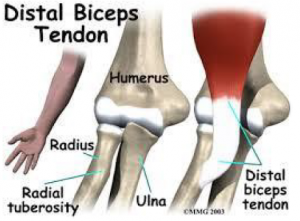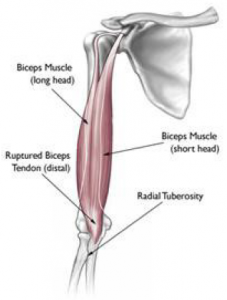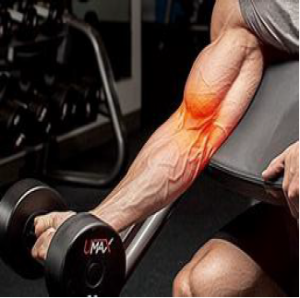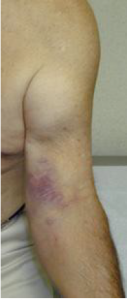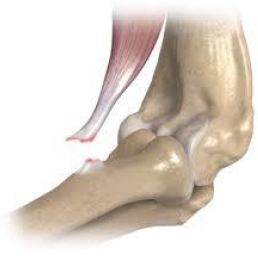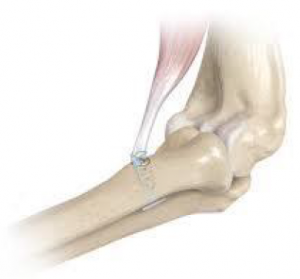Biceps Tendon Injury at the Elbow
What is the biceps tendon?
The biceps tendon is a bipennate (two heads) tendon that attaches the biceps muscle to the radius in the forearm.
Its main action is to supinate (forcefully rotate the palm up) and to flex the elbow
What kinds of biceps injuries are there?
Biceps tendonitis and complete biceps rupture are the two types of injuries. They likely both part of the same disorder. The tendon insertion on the radius has a poor blood supply and therefore may become injured through use or with age. This inflammation due to the body’s attempts at healing this tendon can cause pain. Conversely, a frank rupture can occur. Sometimes there is a presenting period of pain in the anterior elbow before the tendon pops, but most of the time it is just a sudden tear of the tendon.
Who gets biceps tendon injuries?
Typically, weekend warriors get biceps ruptures. They are almost always male between the ages of 35-60. Steroids can also be implicated. Biceps tendonitis is less common or at least less diagnosed. These can be in men and women and present with anterior elbow pain, pain with lifting, pain with supination. There may or may not be an inciting injury.
How are biceps tendon injuries diagnosed?
A complete rupture is usually obvious if the tendon retracts up to the arm. Often, a tight band of tissue in the arm prevents the tendon from retracting after the injury. There will be significant pain, swelling and often subcutaneous bleeding. An MRI is diagnostic.
Tendonitis is diagnosed with a physical examination: pain with resisted supination, pain when pushing on the biceps tendon, and pain with resisted flexion. In addition, x-rays and MRI are essential in making the diagnosis and to rule out other problems like radial nerve irritation.
How is biceps tendonitis treated?
If it is early, biceps tendonitis can be treated with supervised physical therapy. More than 50% of the time, patients will fail physical therapy and require operative treatment.
Surgical treatment consists of removing the remaining biceps tendon from the radius bone and reattaching it as if it were acutely torn. The rehabilitation is the same after surgical treatment as an acute rupture. The outcome of surgical treatment is excellent in most cases.
How are biceps ruptures treated?
Biceps ruptures are usually treated surgically. Non-surgical evaluations of patients show that not repairing a biceps tendon at the elbow can result in up to a 70% loss in supination strength and a 40% loss of elbow flexion strength. With the advent of new surgical techniques and hardware, surgeons can reattach the biceps through a drill hole in the bone with excellent results.
Complications of surgical treatment increase with time from injury to surgery. This means time is of the essence for surgical treatment for acute ruptures.
Can chronic, long-standing biceps tendon ruptures be treated surgically?
The answer to this is yes. Most orthopedic surgeons won’t treat a biceps tendon rupture after 2-3 weeks. I have treated patients as late as 6 years after injury. Ideally, we would treat patients earlier, but sometimes they present late for a myriad of reasons.
For chronic injuries, we use a tendon graft, either from the patient’s leg or more commonly from a tissue bank. The reason for surgical treatment late is continued pain or weakness. The cosmetic deformity may persist, but strength will improve.

